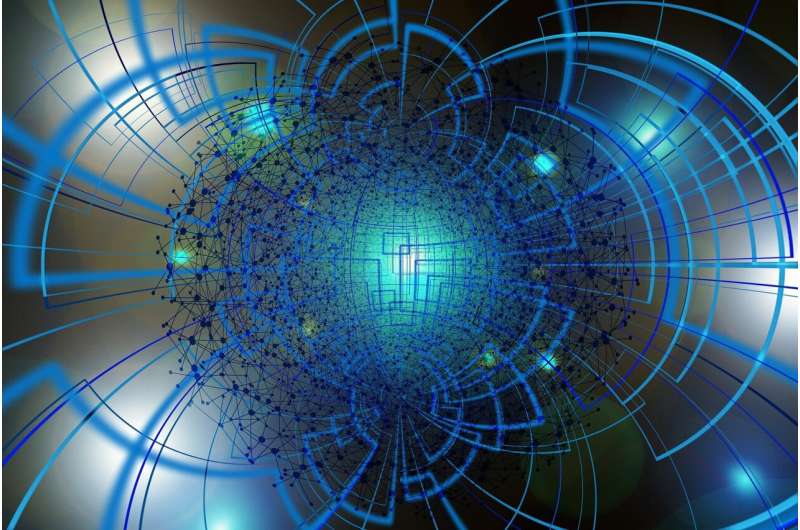Mathematician Asserts Non-Existence of Maximally Entangled Quantum States with Fixed Spectra Under Noisy Conditions

August 21, 2024 feature
This article has been reviewed according to Science X's editorial process and policies. Editors have highlighted the following attributes while ensuring the content's credibility:
- fact-checked
- peer-reviewed publication
- trusted source
- proofread
by David Appell , Phys.org
For more than 20 years, quantum researchers have wondered whether a quantum system can have maximum entanglement in the presence of noise. A mathematician from Spain recently answered the question: No.
The idea of quantum entanglement began with a debate between Niels Bohr and Albert Einstein; Einstein didn't like the notion and derisively called it 'spooky action at a distance.' Quantum physicists puzzled over the concept for decades, and it was refined into a fundamental principle known as the Bell inequalities, which delineated the classical and quantum realms.
Entanglement occurs when the objects in a system, whatever they are, cannot be described independently of one another. They are somehow connected in ways scientists have not been able to explain—or rather, understand, since it seems so unintuitive to us classical beings who do classical, not quantum, thinking.
Quantum scientists are using the entanglement phenomenon to build and improve technologies such as quantum computers, quantum encryption, quantum sensors and quantum teleportation, and want to go further.
Many quantum scientists believe that quantum computers will require particles or molecules in an entangled state. Such states exist only in quantum mechanics. Consider a system of two entangled electrons whose net spin is zero. Measure the spin of one and, whatever it is, the entangled partner seemingly immediately falls into the opposite spin, no matter the distance.
However, rather mysteriously, no information has traveled between the two particles. Entanglement has been demonstrated for a system whose members are more than 1,000 km apart.
A qubit is a quantum bit, where the state (here, an electron) can exist in multiple states at the same time; the electron is said to be in a quantum superposition. Above, before it is measured, each electron is a qubit, a superposition of a spin up state and a spin down state. The maximally entangled quantum state of two qubits is called a Bell state; the qubits exhibit a perfect correlation that cannot be explained without quantum mechanics.
In recent decades, scientists and engineers have come to view entanglement as a resource enabling tasks in quantum technologies that are impossible in classical systems. When using quantum entanglement, researchers would like to attain a maximally entangled state, where the particles, light or molecules have maximum entangled connections to one another in the real world—the particles are correlated in a way that is not possible in the classical world, and all possible measurements of the entangled system can be performed. This would provide the most useful form of entanglement and would be a gold standard in applications.
In the absence of any noise—any disturbance of the entangled state, such as thermal fluctuations, mechanical vibrations, fluctuations in the voltage of a power supply, etc.—quantum information theorists know the maximally entangled state exists, which is independent of measurements.
But the real world has unavoidable noise knocking on the doors everywhere, including on entangled states. Can the maximally entangled state still exist? Indeed, this question is ranked number 5 on the list of open quantum problems published by the Institute for Quantum Optics and Quantum Information in Vienna.
Now Julio I. de Vicente of the Universidad Carlos III de Madrid has answered the question in the negative—if noise is present, it is not possible to simultaneously maximize all types of entanglement of the system. His work is published in Physical Review Letters.
'The best state that one can prepare depends on the choice of entanglement quantifier as soon as we move away from the idealized scenario even under the slightest form of noise,' de Vicente told Phys.org. 'Thus, in the noisy regime, there is no universal notion of maximal entanglement, and the best state one can prepare is task dependent.'
An 'entanglement quantifier' assigns a number to the degree of entanglement. A 'task' in this context is the purpose for which an entangled state is utilized.
It is important to understand that Vicente's result only applies to noisy maximally entangled states with a fixed spectrum. Two quantum states have the same spectrum if they have the same amount of underlying noise. de Vicente's results do not apply to the case where we are allowed to change the spectrum (that is, increase or decrease the noise) between two quantum states.
One important entanglement quantifier is entanglement entropy; as in thermodynamics, it is a measure of the amount of disorder in a system. The Bell states have a high amount of entropy, and two-qubit noisy states were known to maximize other quantifiers of entanglement. It was strongly believed that they should maximize all possible quantifiers, which now turns out to be incorrect.
Namit Anand, a staff scientist at KBR and the NASA Ames' Quantum AI Lab (QuAIL), says, 'This comes as a surprise, since it was known that there exist classes of noisy two-qubit states that seem to be like the generalization of the Bell state.' But de Vicente's proof implies, among other things, that the equivalent of the Bell state doesn't exist in the presence of noise.
'This reminds us that the story is not as simple as it seems,' Anand said. 'And perhaps, as often happens in fundamental research, when an open problem is solved, it leaves us with more questions than answers.'
The author thanks Namit Anand for valuable insights and assistance.
More information: Julio I. de Vicente, Maximally Entangled Mixed States for a Fixed Spectrum Do Not Always Exist, Physical Review Letters (2024). DOI: 10.1103/PhysRevLett.133.050202. On arXiv: arxiv.org/abs/2402.05673
Journal information: Physical Review Letters , arXiv
© 2024 Science X Network




